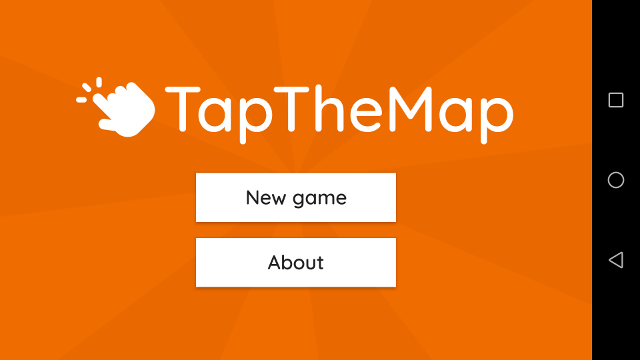TapTheMap is available in Google Play: https://play.google.com/store/apps/details?id=pl.gov.stat.tapthemap
It can be installed directly from APK file (app-release.apk) as well - please follow the instructions: https://www.wikihow.tech/Install-APK-Files-on-Android
To play the game a special marker is required. It should be downloaded and printed form this repository (tap-the-map/tree/master/app/src/main/assets) or from application website: https://hackathon.stat.gov.pl/aplikacje/tap-the-map. The marker is available in two versions: colour or black-and-white.
TapTheMap is a native Android app written in Java. As usual, project is build for gradle, preferably for use with Android Studio. The application itself is contained in app subproject, with a default run configuration app targeted at devices with API level 24+. App uses Java 8, the newest supported by Android SDK at the time of development (April 2018).
Europe map rendering is done trough a 3rd party library called Rajawali. The renderer is completely independent from the AR library. By design, there should be no references to ar package from scene. MapRenderer can have a RenderingDelegate bound to itself, to handle events important for AR libraries, like GLSurfaceView being attached to screen. The intent of this division was to:
- Enable gameplay for version not using augmented reality at all;
- To make it simpler to switch to some other library later, for example to ARCore when the device coverage gets bigger
Internet connection is necessary to use the application. The first thing is, EasyAR requires an application to register itself every time a tracking engine starts. The application does not work otherwise. Second this is, the datasets by Eurostat change relatively often (~every few months). By downloading the data every time, we greatly imcreasy application liveability. Since there is no advanced data analysis, the single request is done in an AsyncTask initiated in LoadingFragment.
Questions are the basis of the gameplay. These are based on data that changes relatively frequently, what leads to a few observations:
- We expect the question set to evolve and possibly be expanded in the future;
- Regarding the initial game project, there's a chance question list will be curated online and sent to the devices at application runtime.
That's why all questions are kept in a single JSON file, so it can later be easily integrated in an online workflow. This is also means the question text translations are stored along the data.
We use country identifiers in multiple places of the app. Country is an identifier class from which you can obtain both ISO alpha 2 codes (e.g. GR for Greece) and codes given by European Union (e.g. EL for Greece). European country codes, received from Eurostat API, are here. Country class should be used wherever possible for consistent ID handling. Names of all assets (OBJ files, textures etc.) use EU names.
Main application flow is divided into Activities, and Fragments in case of GameActivity.
Open project in Android Studio 3.1.0 or higher. Compile app configuration.
- The main package: activities and general utility classes, e.g. for work with
SharedPreferences. ar: support for AR and classes needed to connect with 3D renderercommunication: handles downloading data from public Eurostat databasesgame_ui:Fragments used to implementGameActivitygameplay: Encapsulates game logicscene: 3D renderers, classes representing 3D objects
All libraries are added as gradle dependencies in app/build.gradle
All game settings are hardcoded in .gameplay.Gameplay.Settings. In future, these can be moved to a separate file or download from somewhere.
Application uses EasyAR to handle augmented reality. All marker images are defined in assets/targets.json, images are held in the same folder.
- Locate the file
assets/questions.json. Standard json file. It contains all necessary data to download questions from Eurostat API and display them properly in application. - In the file one can find a list of dictionaries. Each dictionary represents one question. Consists of following keys:
query- query for Eurostat API (query that one can acquire from Eurostat API Query Builder, but you should not add countries and precision in the query, the application will set the propper values by itself)multiplier- multiplier of the prefix of the unit (e.g.1000000)base_unit- the base unit used in the question (e.g.€) (in this casemultiplierandbase_unitrepresent the question, where the unit is milions of euros)category- category of the question based on Eurostat, possible categories are listed in pl.gov.stat.tapthemap.gameplay.QuestionCategory enumlocalized_text- JSON map, consists of country codes as keys and translations of the question string that is displayed to the user
- In order to add a question one need to create a new dictionary and place it in the main list.
- In order to add a new marker to the application, one need to add a
*.pngfile to the assets directory. - One also need to add a new entry in
assets/targets.jsonfile. In the main dictionary, for the keyimagesthe value is the list of the dictionaries containing entry for each marker that application is aware of. Each of dictionaries consists of following keys:
image- name of the fileuid- id of the marker (might be any arbitrary id)name- name of the marker (might be any arbitrary name)size- says how big the marker size is in the virtual world ([1, 1]by default, we use[2.5, 2.5])
Copyright © 2018 Główny Urząd Statystyczny
Contents of this repository is licensed under GNU General Public License, version 3.0 (GPL-3.0).

